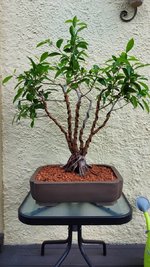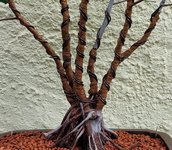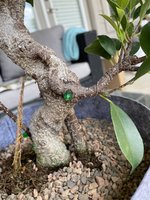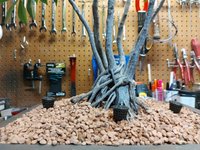Ugo
Shohin
Hi everyone,
Question about styling on my ficus retusa.
This tree has all my respect being my test tree since years now.
I made all kind of mistakes (and still do) , tried any type of different things, been left in cold temperature for months with no direct sun, inadequate subtrat and so on.
He still alive! And now its time for me to give back.
I repotted the tree last spring with light roots prunning.
The tree responded well starting new shoots everywhere.
This picture is from last April.

Better shot of the nebari.

Here the tree today after wiring.

I left all the foliage on top leaving the tree grow for summer.
I think the tree could be a good canditate for a clump style bonsai but I prefer asking questions as I dont have experience with this styling.
So far I wired the mains trunks to give them more movements as few of them were almost straight.
I have a question about possible agressive cutting.
Before doing all that I will left the tree grow for 2 years, in an atemp to have a bigger nebari and more aerial roots to create a bigger taper.
Even if I woukd let the tree grow for 2 years before doing anything else I would like your opinion.
Should I shorten ( if possible) the multi trunks
For a maximum trunk lenght like this:

I could also leave it as it is now and start top ramification but side branches might have to be shortened.
As the tree as no ramification on top this is also an option but it is difficult for me to have a clear picture of this tree in the future due to lack of experience.
My second question is about nebari.
I understand the basic technique to have a good nebari in general but with ficus you also get the option of aerial roots.
I did some experiences in the past as you can see. Which worked quite well.
I missed good opportunities with the roots.
I could use this same technique again, but the main problem is that I dont have a growing room with high himidity level with a multi trunk tree like this one I find it hard to seal the plastic bag.
I would like to know if I could add a plastic pot with air holes around the trunk and add a draining substrare to encourage root grow everywhere around the trunk.
In about a year or so I could remove the pot and wire the new roots in choosen places.
I felt that by damaging the bark and adding root hormones the trunk could be even more conical and wide using a pot.
Please correct me if Im wrong.
Thanks for your time
Ugo
Question about styling on my ficus retusa.
This tree has all my respect being my test tree since years now.
I made all kind of mistakes (and still do) , tried any type of different things, been left in cold temperature for months with no direct sun, inadequate subtrat and so on.
He still alive! And now its time for me to give back.
I repotted the tree last spring with light roots prunning.
The tree responded well starting new shoots everywhere.
This picture is from last April.

Better shot of the nebari.

Here the tree today after wiring.

I left all the foliage on top leaving the tree grow for summer.
I think the tree could be a good canditate for a clump style bonsai but I prefer asking questions as I dont have experience with this styling.
So far I wired the mains trunks to give them more movements as few of them were almost straight.
I have a question about possible agressive cutting.
Before doing all that I will left the tree grow for 2 years, in an atemp to have a bigger nebari and more aerial roots to create a bigger taper.
Even if I woukd let the tree grow for 2 years before doing anything else I would like your opinion.
Should I shorten ( if possible) the multi trunks
For a maximum trunk lenght like this:

I could also leave it as it is now and start top ramification but side branches might have to be shortened.
As the tree as no ramification on top this is also an option but it is difficult for me to have a clear picture of this tree in the future due to lack of experience.
My second question is about nebari.
I understand the basic technique to have a good nebari in general but with ficus you also get the option of aerial roots.
I did some experiences in the past as you can see. Which worked quite well.
I missed good opportunities with the roots.
I could use this same technique again, but the main problem is that I dont have a growing room with high himidity level with a multi trunk tree like this one I find it hard to seal the plastic bag.
I would like to know if I could add a plastic pot with air holes around the trunk and add a draining substrare to encourage root grow everywhere around the trunk.
In about a year or so I could remove the pot and wire the new roots in choosen places.
I felt that by damaging the bark and adding root hormones the trunk could be even more conical and wide using a pot.
Please correct me if Im wrong.
Thanks for your time
Ugo

















